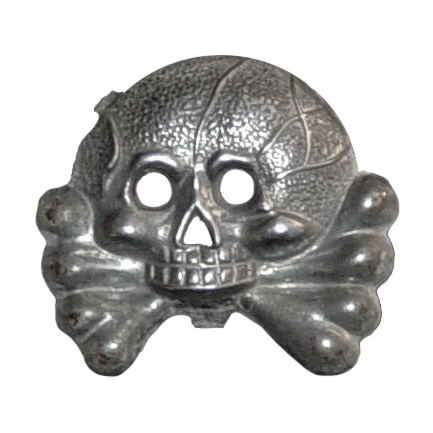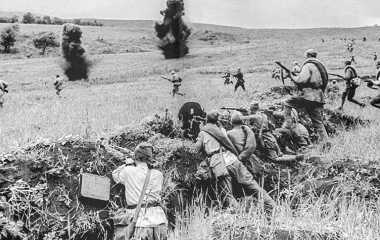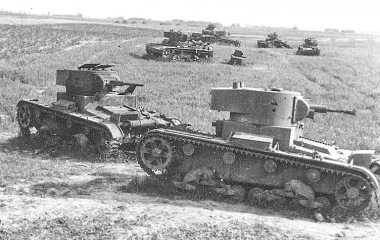
5 July 1943 – 23 August 1943
Battle of Kursk
Commanders of the Battle of Kursk

Georgy Konstantinovich Zhukov

Erich von Manstein

Konstantin Rokossovsky

Walter Model
The Battle of Kursk or Operation Citadel was a large and decisive tank battle on the Eastern Front in World War II. It marked the end of the German offensive capability on the Eastern Front and cleared the way for the great Soviet offensives of 1944–45. This battle also saw the day with the greatest losses in the history of the air war. The battle took place in July and August 1943 between Nazi Germany and the Soviet Union near the city of Kursk in Russia. 900.000 infantry, 2.700 tanks and 2.000 aircraft were deployed on the German side and 1.300,000 infantry, 3.600 tanks and 2.400 aircraft on the Soviet side.
After the Battle of Stalingrad, the great losses resulted in a troop shortage on the Southern front. Von Manstein therefore had his troops withdraw in order to extend the supply lines of the Red Army. The Russians were convinced that the German army was almost defeated and that the war was nearing its end. However, the Germans were still able to carry out attacks on the Russians. The Germans gathered their own troops near the city of Krasnograd and on February 18, 1943 launched a counter-offensive towards the city of Kharkov on the right wing of the Russians where General Nikolai Vatutin was located. The Russian forces were quickly driven back. To help Vatutin, Filipp Golikov wanted to attack the flank of the Germans, but the Stavka considered that plan too risky because Golikov himself could be surrounded by the Wehrmacht and the Russians faced supply problems. The Russian forces therefore withdrew behind the Donets after the city of Kharkov was lost.
Stalin saw that the situation was becoming serious and called in Zhukov. He immediately gave the order to send all reserves to Belgorod. On March 18, 1943, the Germans attacked Belgorod, but the Wehrmacht was quickly brought to a halt. Due to the thaw that had meanwhile set in, both parties had to wait at least six weeks: in the thaw tanks could hardly or not move forward because the vehicles sank into the mud created by the thaw, the raspoetitsa. It gave both sides time to bring in weapons, men and supplies. This particularly benefited the Russians with a tank production of about 2,000 tanks per month. In the meantime, the Germans had to make do with about 100 tanks a month and, moreover, the German troops had problems supplying enough spare parts.
Von Manstein knew that the Wehrmacht could only go on the defensive. At most, he could launch an attack somewhere locally. Von Manstein saw an opportunity to recapture the salient (bulge in the front line) at Kursk. When Operation Citadel began, both sides had already gathered a lot of troops and equipment. Von Manstein immediately wanted to attack, but Hitler ordered him to wait for more Tiger tanks to arrive.
German plans
Von Manstein wanted to push the southern wing of the Russians back to the Sea of Azov and encircle them there. However, the Oberkommando des Heeres (OKH) had a completely different plan in mind. The OKH's plan was quite simple. Heeresgruppe Mitte led by General Von Kluge and Heeresgruppe Süd led by Von Manstein would try to encircle the salient. In this way they could take revenge for Stalingrad and repeat the successes of encirclement battles such as in 1941. Little did the Germans know that an anti-Nazi, Rudolf Rössler, was sending all plans for the offensive from Switzerland to Moscow. It is not known exactly how he obtained this information; he may have had high contacts in the OKH, but it has also been suggested that he passed on the British Ultra information without the origin being recognizable. Alfred Jodl said during the Nuremberg Trial that the messages were in Moscow rather than at his own desk.
Soviet plans
Stalin ordered Zhukov to attack the Germans immediately, but Zhukov decided to wait in a defensive position. The Russians themselves were also preparing offensives. They wanted to attack the Germans in the summer and recapture Oryol and Kharkov. This could lead to a breakthrough in the swamps around Prypjat. However, the Soviet commanders had considerable concerns about the German plans and also took into account that they might have to go on the defensive. The Soviets were wary of the German blitzkrieg tactics. General Zhukov commandeered 300.000 civilians to dig anti-tank ditches with the shovel. He also had 500.000 anti-tank mines laid. In the end, General Zhukov decided that the Russians should defend the bulge in such a way that the Germans would break their teeth on it. After that, the Russians would immediately launch a counterattack to destroy the remaining German reserves.
Soviet Red Army

German Wehrmacht

Battle specifications
Date of the battle
Duration of the battle
Reason for the battle
Location
Battle result
Allied casualties
-
Killed: 254.470
-
Wounded: 608.833
-
Planes lost: 3.000
-
Vehicles lost: 7.000
Axis casualties
-
Killed: 111.132
-
Wounded: not known
-
Planes lost: 681
-
Vehicles lost: 750 - 1.200
The offensive
The Russians knew that the Germans would attack with a large number of tanks. They therefore equipped their positions with an abundance of anti-tank weapons and built minefields. The Russians quickly expanded their defenses to six defensive belts. The mobile troops were initially kept in reserve. Meanwhile, partisan groups constantly hindered German supplies.
According to the original plans, the Germans would attack in May. Hitler, however, insisted that the attack be delayed until his new wonder weapons were ready: The Panther and the Elefant tanks. On July 2, 1943, Hitler announced that the offensive would start on July 5. Most German generals thought that the attack should have taken place much earlier, because aerial reconnaissance had revealed what was in store for them. The generals also feared that, over time, troops would be needed to fight an invasion in the Mediterranean. The Russians suspected that the attack would take place between 3 and 6 July. On July 4, when they saw the Germans begin to remove their barbed wire and mines, General Rokossovski gave the order to shoot at the Germans with planes and artillery. The Germans also started to fire back.
At 5:30 am, General Model launched a mock attack against the Russians on the North Flank. The main attack was carried out two hours later. Rokossovski launched a large number of armored aircraft to bombard the German tanks from a low height. The Germans immediately suffered serious losses.
In addition to the air raids, the Germans also suffered significant losses in the minefields that had been built, especially among the tanks. In addition, the tanks in the minefields had little freedom of movement and became an easy target for anti-tank guns. The infantry could no longer take advantage of the cover that advancing tanks normally provided. After heavy fighting, the Germans managed to break through the Russians' first line of defense. The counterattack that was launched by the Russians could be repulsed. The next day the Germans resumed their attack and suffered significant losses again. Despite this, the Germans managed to push through to Ponjri and Molotjstshi. However, the Russians quickly regrouped and recaptured the lost positions. They would change parties twice that same day. Model gave the order to take the city of Ponjri, to make it a strong defensive position, but his troops were unsuccessful.
The Germans had an easier time on the south side of the salient, as the Russians needed a lot of power to repel Model's main attack in the north. General Hoth led the troops to the south. He originally wanted to advance to Obojan, but ran into Russian tanks and infantry. He therefore decided to deal first with the Russian reinforcements near Prochorovka. After a series of fierce fighting, the defenders were defeated and the Germans were able to advance to Obojan. Since Hoth usually carried out his attacks on his own initiative (without order from the German army command), Rudolf Rössler was hardly informed. Normally the Russians knew where the Germans were about to attack. However, now, without Rudolf Rössler's vital information, they were often left in the dark. The Germans took advantage of this (unconsciously) and were able to defeat the wrongly positioned troops without much effort.
Prochorovka
The largest tank battle in history took place on the fields around Prochorovka. The Russians attacked en masse on July 12 with hundreds of tanks. Hoth also deployed his tanks in response. Much has been written about this tank battle and only recently has it come to light what really happened. Many of the articles are riddled with false information based on Russian propaganda, which has been believed to be true over the years. It was supposed that Germany would have lost at least 400 tanks, including more than 200 Tigers, while not even that many Tigers had been used in the entire battle of Kursk, because production of the Tigers was low.
In reality, losses were comparatively much lower, while the Russians suffered very heavy losses. According to the latest readings, the German assault spurs at that time owned 186 armored vehicles, of which 117 were tanks. The Russian general Pavel Rotmistrov had advanced unexpectedly quickly from the east with 800 T-34 tanks, of which he deployed 400 directly against the exhausted Germans. Although it is unclear what exactly happened, the vanguard of the Russian tanks would have driven into an anti-tank ditch, after which the drivers of the following tanks tried to panic, becoming an easy target for the Germans and even bumping into each other. The Russian losses that day would amount to 235 tanks against 3 for the Germans. Higher estimates even assume a loss of 822 tanks on the Russian side. The actual numbers are still being investigated. The German Tiger tanks carried a heavier 88 mm gun and had a thicker 100 mm armor. The T34 carried a lighter gun and only 45mm of armor, angled at 60 °, but there were more of them. The Russian tanks drove in a swarm at full speed towards the German tanks, only to open fire from close range. Russian infantry aimed Molotov cocktails at the air vents of the German tanks.
Joseph Stalin was furious about this enormous loss and demanded an explanation. Rotmistrov and his political commissar Nikita Khrushchev (who would later become Soviet leader) are said to have decided to save their careers and perhaps their lives by spreading the myth of the 'heroic battle'. Be that as it may, Russia's losses far outstripped German losses. Von Manstein wanted to exploit the somewhat regained initiative after this tank battle, but after Hitler's intervention, Operation Citadel was called off, due to the landing in Sicily.
Aftermath
During Operation Citadel, a new front was added for the Germans. Hitler knew there would be a landing in the Mediterranean, but it was unknown where and when this would happen. At the most unfavorable moment the time had come: the British and Americans launched an invasion on Sicily on 10 July. With the execution of Operation Husky, Stalin's wish was finally fulfilled: a second front had been opened. Finally the Germans would have to withdraw troops from the Eastern Front. On July 13, Hitler summoned Günther von Kluge and Von Manstein to his headquarters, the Wolfsschanze, in East Prussia. Hitler considered removing troops from the Eastern Front and stationing them in Italy. These would then be troops currently conducting Operation Citadel. Von Manstein really did not want to hand over any troops and told Hitler that one big effort at Kursk would bring him victory. With a rare indulgence, Hitler gave von Manstein a few more days, but then he gave a definitive order to cease the offensive 'temporarily'. Ultimately, only the Leibstandarte-SS Adolf Hitler would leave for Italy for the time being.
End of the battle
The Germans were hit hard. The Russians launched a counter-offensive in the north of the salient. In addition, the British, along with the Americans, had landed in Sicily two days earlier. That meant Hitler had to pick up units from the Eastern Front and transfer them to Italy. The Fuehrer had decided that the attacks could be continued on the south side of the salient. Meanwhile, Hoth had soon carried out a few local encirclements. However, the Russians massively attacked Model's left flank and he had to withdraw in order to avoid encirclement.
By July 15, Hoth's advance had almost come to a halt. The Russians thought it was time to start an offensive in the south as well. The Red Army quickly conquered areas. On July 23, the Russians had already advanced to the area where Operation Citadel had started. Zhukov regrouped his troops and successively Oryol (5 August), Belgorod (5 August) and Kharkov (23 August) were liberated. This meant the first victory for the Russians in a summer offensive. Over the months the Russians were still very successful, although they were stopped one more time at the Hagen Line.
Casualties
Operation Citadel
On German side: 54.182 men, 252 – 323 tanks and assault guns destroyed 1.612 tanks and assault guns damaged, 159 aircraft and 500 guns
On Soviet side: 177.847 men, 1.614 – 1.956 tanks and assault guns destroyed or damaged 480 to 1.000 aircraft
Battle of Kursk
On German side: 111.132 killed men during the Soviet counter-offensives. Estimates between 750 - 1.200 tanks and assault guns destroyed and 681 aircraft
On Soviet side: 254.470 killed, missing or captured (608.833 wounded or sick in a total 863.000 - 1.200.000 men), estimated around 7.000 tanks and assault guns destroyed and approximately 3.000 aircraft and 5.244 guns



















